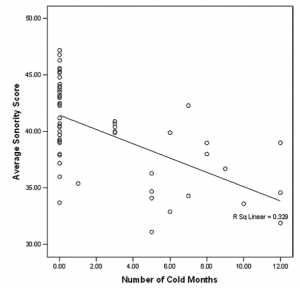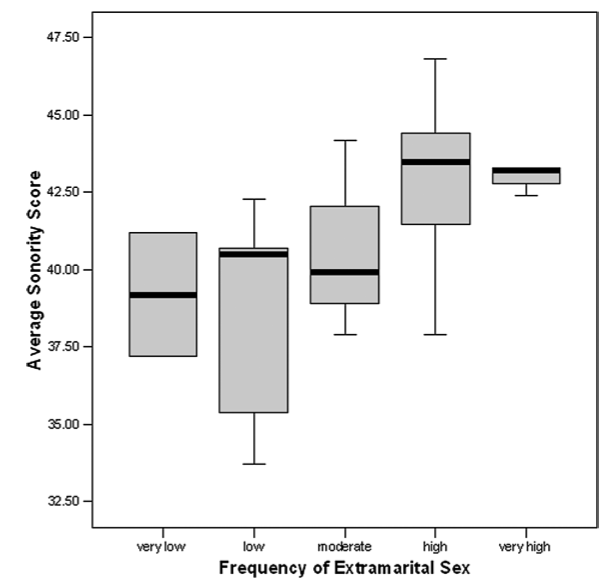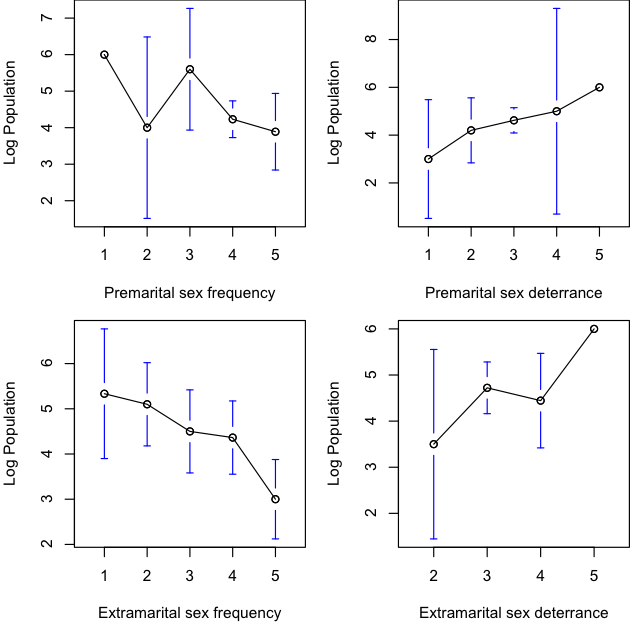![]() Through this post on Sprogmuseet about Atkinson’s analysis of the out of Africa hypothesis, I found an article by Ember & Ember (2007) (who also quantified the link between colour lexicon size and distance from the equator, see my post here) on Sonority and climate. The article extends work by Fought et al. (2004) which finds that a language’s sonority is related to climate. Sonority is a measure of amplitude (loudness) as is greater for vowels than for consonants (for example, see here). Basically, the warmer the climate, the greater the sonority of the phoneme inventory of the population. The theory is that “people in warmer climates generally spend more time outdoors and communicate at a distance more often than people in colder climates”.
Through this post on Sprogmuseet about Atkinson’s analysis of the out of Africa hypothesis, I found an article by Ember & Ember (2007) (who also quantified the link between colour lexicon size and distance from the equator, see my post here) on Sonority and climate. The article extends work by Fought et al. (2004) which finds that a language’s sonority is related to climate. Sonority is a measure of amplitude (loudness) as is greater for vowels than for consonants (for example, see here). Basically, the warmer the climate, the greater the sonority of the phoneme inventory of the population. The theory is that “people in warmer climates generally spend more time outdoors and communicate at a distance more often than people in colder climates”.
However, Ember & Ember note a large amount of variation in the colder climates, and ask what the additional factors may be. They test two types of variables: The first is econiche, measured by number of cold months, plant cover and terrain (mountainousness).
The second type is cultural measures, including the amount of baby-holding, literacy and sexuality, measured by premarital and extramarital sex and attitudes towards promiscuity (the amount of sex deterrence). They find that
“Number of cold months predicts less sonority, the combination of cold climate and sparse vegetation predicts less
sonority, and a higher factor score of premarital and extramarital sex frequency predicts more sonority. The combination of warm climate and dense vegetation is only marginally significant in predicting less sonority”
Interestingly, the cultural factors are better predictors of sonority than the econiche measures. The link with baby-holding is interesting: The more distant the baby is from the caregiver on average, the greater the sonority in the langauge. However, my favourite link is between average sonority and frequency of extramarital sex – this is one of the best graphs I’ve seen in a while:
The idea is that sexual inhibition discourages speaking with a wide open mouth. The theory is linked to Lomax (1968)’s study of folk song styles:
“Lomax (1968) found that premarital sexual restrictiveness predicted two aspects of song style—less vocal width and
greater nasality. Lomax describes vocal width as follows: It ranges from singing “with a very pinched, narrow, squeezed voice to the very wide and open-throated singing tone of Swiss yodelers” (1968:71). A narrow voice is produced by “raising the glottis, raising the tongue and pulling it back, and tensing the muscles in the throat” (Lomax 1968:71). Nasality occurs when the sound is forced through the nose (1968:72–73). The highest ratings on nasality occur when nasality is heard throughout a song, regardless of the actual sounds sung. In Lomax’s view, the singing voice reflects tension about sexuality (Lomax 1968:194). Could opening the mouth wide to make sonorous sounds be partially explainable as an effect of sexual permissiveness?”
Although Ember & Ember hypothesise that “sonority will decrease after people with high sonority move into an econiche that inhibits it. In other words, we suggest that high or low sonority in a language may be selectively advantageous in particular econiches—not just because the climate is warmer or colder”, there’s little talk about language evolution. One thing that’s been discussed a lot recently is the relationship between population size and phoneme inventory (see Wintz’ post here). Could these things be linked?
I looked at population size and sexual tenancies in the Standard Cross-Cultural Sample. Below are plots for population versus pre- and extra- marital sex frequency and deterrence (data from Huber et al. 2004, as in Ember & Ember). Larger populations have less extra and pre marital sex and have stricter attitudes towards them:
A linear regression shows that extramarital sex frequency soaks up most of the variation (r = -0.5, t = -2.2, p = 0.04, p value for log pop v. extramarital sex frequency alone = 0.003). The relationship remains significant when controlling for population density.
If bigger populations have a lower frequency of extramarital sex, they may also have a lower sonority. Can this explain why bigger populations have larger phoneme inventories? If smaller communities spend more time closer together, maybe there’s less chance of drift leading to new phonemes. The measures of attitudes towards sex may be a proxy for the amount of contact people have with others in their community – a sort of macro-scale measure of the kind of thing measured in Lupyan & Dale (2010).
Of course, if languages adapt to the cognitive niche of their users, and those users are having a lot of sex, maybe more sonorous sounds will just be more frequent.
EMBER, C., & EMBER, M. (2007). Climate, Econiche, and Sexuality: Influences on Sonority in Language American Anthropologist, 109 (1), 180-185 DOI: 10.1525/aa.2007.109.1.180
MUNROE, R., & FOUGHT, J. (2007). Response to Ember and Ember’s “Climate, Econiche, and Sexuality: Influences on Sonority in Language” American Anthropologist, 109 (4), 784-785 DOI: 10.1525/aa.2007.109.4.784
Lomax, Alan (1968), Folk Song Style and Culture. Washington, DC: American Association for the Advancement of Science, Publication No. 88.




1 thought on “Sonority and Sex: Why smaller communities are louder”